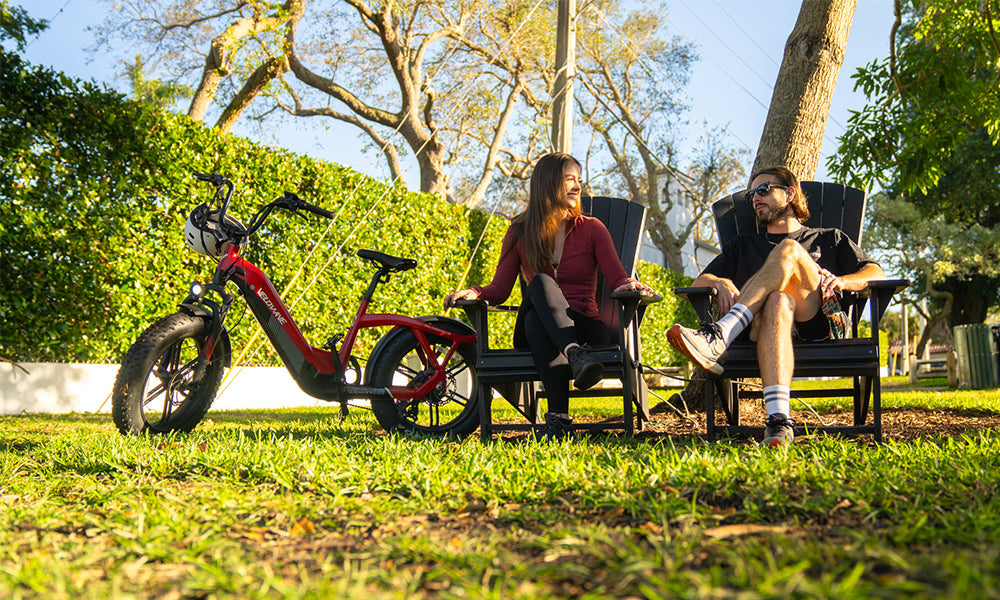
Choosing a Car or E-bike for Commuting: What’s Best for You?
When it comes to daily commuting, many of us face a crucial decision: should we choose a car or an adult electric bike? Okay, let us watch a short video first! And then picture this: you’re stuck in traffic, running late for work, watching the minutes slip away. Meanwhile, a cyclist glides past, weaving through gridlock. This choice not only affects your comfort but also impacts your costs, health, and flexibility in navigating traffic.
In this blog, we’ll explore why and how you should choose an electric bike.
Cost Comparison
Let’s talk about money — one of the biggest advantages of choosing an adult electric bike over a car is the cost. The initial price of an electric bike is often just a fraction of what you’d pay for a car.
- E-bikes have much lower maintenance costs.
- Cars come with regular servicing, fuel, insurance, and other expenses that quickly add up.
In contrast, the maintenance of an adult electric bike generally involves just charging the battery and occasional part replacements, with minimal electricity costs.
- For example, if your daily commute is about 10 kilometers, driving could cost you hundreds of dollars a month in fuel and parking. According to a survey by Xinhua News, American drivers spent an average of $10,288 on driving-related expenses in 2017, with parking fees being the highest single expense. These costs include vehicle depreciation, maintenance, gasoline, insurance, and more, with 45% of expenses coming from parking fees and congestion costs. The report also shows that New York City has the highest driving costs in the U.S., with an average expenditure of $18,926 per driver in 2017, where parking fees account for 46% of total expenses. Los Angeles and San Francisco follow closely behind.
And if you choose Velowave, you’ll benefit from a warranty that covers parts damaged by natural wear and tear, allowing for free replacements.

Avoid Traffic Jams
Traffic jams are a common headache in busy cities. Cars often get stuck in long queues, making your commute even longer. On the flip side, adult electric bikes can easily navigate narrow streets, avoid congested main roads, and bypass peak-hour traffic jams. If you live in a traffic-heavy area or commute during rush hours, an e-bike offers a more flexible and faster alternative.
Many cities have dedicated bike lanes, further enhancing the efficiency of e-bike commuting. Plus, parking is a breeze; you can park almost anywhere without the stress of finding a spot.
Health and Development Benefits
Electric bikes not only reduce commuting stress but also offer health benefits. While an adult electric bike assists with power, you still need to pedal, which helps improve cardiovascular health and build stamina. Plus, e-bikes are a sustainable choice, allowing you to do your part in reducing urban pollution.
Know Your Local Regulations
Before choosing an adult electric bike for commuting, it’s crucial to understand local laws and regulations. E-bikes are typically divided into three classes, each with different restrictions:
- Class 1: Pedal-assist only, no throttle, with a moderate speed limit.
- Class 2: Equipped with a throttle, allowing the rider to power the bike without pedaling, with a similar speed limit to Class 1.
- Class 3: Pedal-assist only but capable of higher speeds, often subject to stricter regulations regarding bike path access and safety gear requirements.

Choosing the Right E-bike
When selecting an e-bike, consider your specific needs and local regulations. Your choice of adult electric bike should depend on your commute distance, terrain, and road conditions:
- Short Distance on Flat Terrain: If your commute is short (under 5 kilometers) and mostly flat, a lightweight Class 1 or Class 2 e-bike will suffice.
- Medium Distance and Moderate Hills: For a commute of 10 to 20 kilometers or if you need to tackle some inclines, a Class 2 or Class 3 e-bike is recommended. Class 2 offers throttle power for an extra boost on hills, while Class 3 allows for higher speeds, cutting down commute time.
- Long Distance or Challenging Terrain: If your commute exceeds 20 kilometers or involves complex terrain, a Class 3 e-bike with higher speeds and longer battery life will serve you best.
All of Velowave's current models fall into Class 2 and Class 3, so if you’re looking for an adult electric bike, check out Velowave!
Local Resources and Support
If you’re unsure about committing to an e-bike, consider visiting local bike shops or rental services. Many cities offer resources for test rides and consultations to help you choose the right model. Velowave has offline stores in many states where you can take a test ride and speak with knowledgeable dealers.

Conclusion
In summary, an adult electric bike offers significant advantages over cars in terms of cost, traffic flexibility, health, and development impact. When choosing an e-bike, think about your commuting distance, road conditions, and terrain, and ensure you comply with local regulations. Whether you opt for a Class 1, Class 2, or Class 3 adult electric bike, selecting the right transportation tool can enhance your commute and make your daily journey more efficient and enjoyable.
So, what’s stopping you? Share your commuting experiences below, and let’s see if an adult electric bike might just be the perfect solution for your daily grind!




